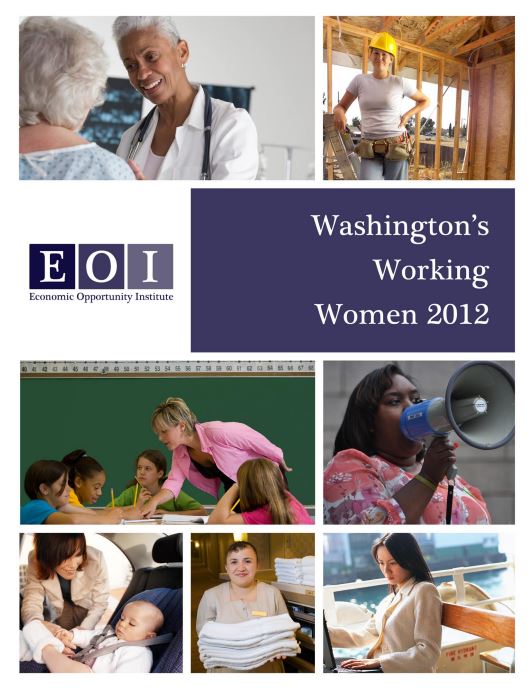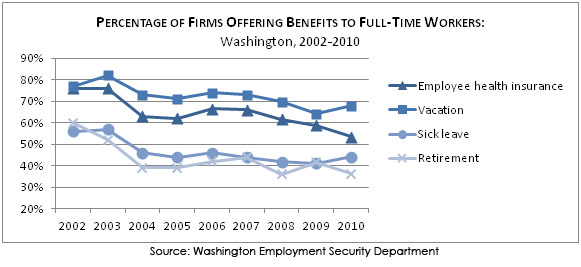A widening gender wage gap, declining workplace benefits, and state budget cuts are putting Washington’s women at risk for more economic instability and poverty in 2012, according to a new report from the Economic Opportunity Institute, Washington’s Working Women 2012.
Women continue to earn less than men overall – and the gap is widening. In 2010, women brought home just 63% of men’s monthly earnings – an average difference of nearly $1,900. That ratio is worse than 1991, when women made 65% of men’s average monthly pay.
Declining workplace benefits are also endangering women’s economic security. In 2010, Washington firms were less likely to offer every type of workplace benefit than in 2002.
- In 2002, 76% of firms provided health insurance to full-time employees; just 54% provided the benefit in 2010.
- In 2002, 60% of firms offered retirement benefits to full-timers, down to 36% in 2010.
- In 2002, 56% of firms offered sick leave to full-timers, down to 44% in 2010.
Part-time workers – the majority of whom are women – are also less likely to receive every type of benefit. In 2010, just 15% of businesses provided retirement benefits, 22% provided vacation and 11% offered health benefits to part-time workers.
The private sector began to show signs of recovery in 2010, but many of the jobs gained were in the male-dominated sectors of manufacturing, wholesale trade and software publishing. And as state budget problems compound, public sector cuts have hit women particularly hard. Between February 2010 and October 2011, 6,000 jobs in public schools were cut – 74% of which were held by women.
All of these factors have contributed to more Washington women – and their children – living in poverty. In 2010, Washington women were more likely to live in poverty than men, with more than 1 in 7 females (14.5%) living below the poverty line. And two-thirds (63%) of children in single-parent families live below 200% of poverty.  Women will continue to struggle to achieve economic security until employers and policymakers take adequate steps to reduce gender gaps in earnings, access to benefits, and likelihood of experiencing poverty throughout life.
Women will continue to struggle to achieve economic security until employers and policymakers take adequate steps to reduce gender gaps in earnings, access to benefits, and likelihood of experiencing poverty throughout life.
Across the country – and in Seattle – advances have been made or proposed to help increase worker economic security. Ultimately, building a better work environment for women will also contribute to a stronger economy for Washington.
More To Read
April 17, 2024
2023-24 Impact and Gratitude Report
Reflecting on a year of progress and transition at Economic Opportunity Institute
April 12, 2024
Welcoming our New Executive Director, Rian Watt!
EOI is excited to begin its next chapter under new leadership
April 4, 2024
Is There a Valid Argument Against Cost-Free College in Washington?
Cost-free college is a meaningful investment that would change lives. What's stopping Washington from making it happen?


